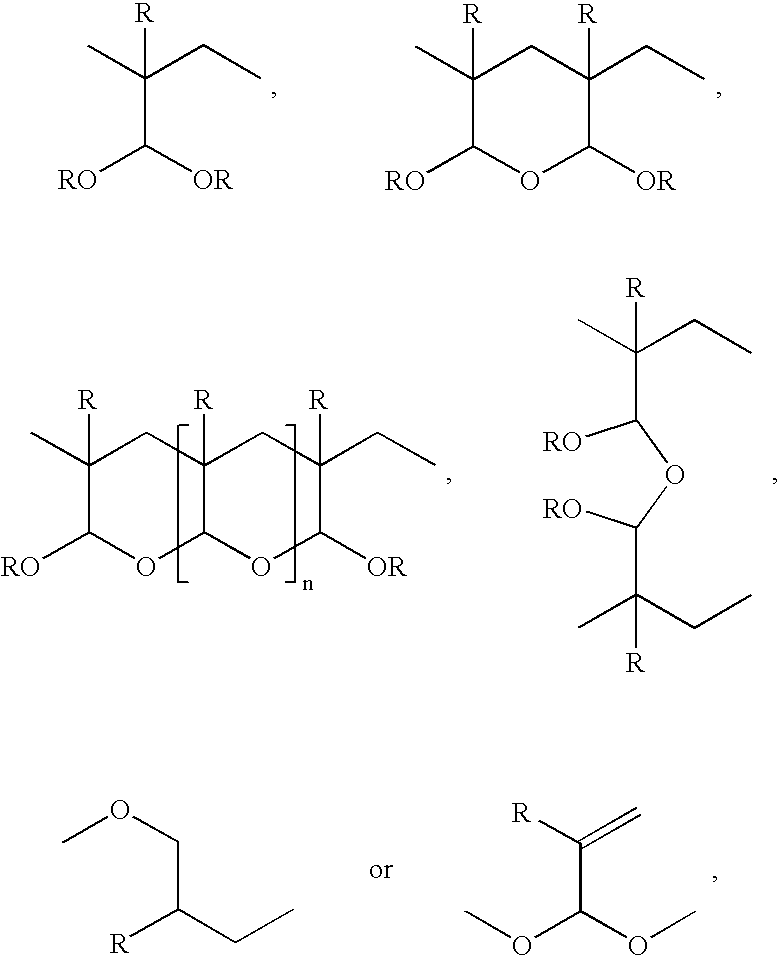Chemotherapeutic compositions
a composition and composition technology, applied in the field of chemotherapeutic compositions, can solve the problems of antimicrobials giving weight-gains, death, or the young weaner failing to make normal weight-gains, and in vitro active antimicrobial agents that are not effective in vivo in the gastrointestinal tract, so as to prevent and treat the effect of weight gain and weight gain reduction
- Summary
- Abstract
- Description
- Claims
- Application Information
AI Technical Summary
Benefits of technology
Problems solved by technology
Method used
Image
Examples
example 1
(a) Using a free radical initiator / free radical catalyst: 9.64 g distilled acrolein and 25 g methanol were placed in a 100 ml round bottom flask and purged with nitrogen. 0.525 g benzoyl peroxide was added and the solution stirred under nitrogen at 60.degree. C. The reaction was allowed to continue for a total of ca. 88 hours. After this time the reaction solution had become strongly yellow in colour and had a solids content of 30.5%. .sup.13 C-NMR (300MHZ) .delta. ( relative to d.sub.4 -methanol at 49.00): 33.27 (CH); 33.53 (CH); 33.79 (CH); 33.87 (CH.sub.2); 37.03 (CH); 37.29 (CH); 37.54 (CH); 37.64 (CH.sub.2); 97.15 (CH); 103.37 (CH); 104.34 (CH); 139.36 (CH); 139.78(CH.sub.2); 196.72 (CH). The .sup.13 C-NMR spectrum shows some residual acrolein with the aldehyde carbon at .delta.196.72 and the vinylic CH.sub.2 and CH at 6139.78 and .delta.139.36, respectively; apart from the .delta.196.72 (CH) resonance absorption, there was no other attributed to --CHO. The spectrum is consiste...
example 2
6.489 g distilled acrylic acid, 0.56 g distilled acrolein and 15 g methanol were placed in a 50 ml round bottom flask and purged with nitrogen. 0.33 g benzoyl peroxide was added and the solution stirred under nitrogen at 60-65.degree. C. The reaction was continued for ca. 66 hours. After this time the contents of the flask had become very viscous, having a solids content of 57.7% (indicating 100% conversion).
A sample of the viscous material was placed on a petri dish and dried on a hot plate to remove solvent. Drying was completed in an oven at 80.degree. C. and a transparent, slightly yellow coloured polymer was obtained. The copolymer is completely soluble in warm water (ca. 50.degree. C.) and once dissolved remains so, even on cooling the solution.
In order to ensure that the solids obtained were polymeric, a simple dialysis experiment was performed: 10 g of an aqueous solution containing 0.65% solids was placed in a dialysis tube. This was irrigated with water continuously for ca...
example 3
2.8 g of acrolein diethyl acetal was placed in a 100 ml round bottom flask and the contents purged with nitrogen. A solution of 0.216 g potassium persulphate in 7.5 g water was added with stirring. under nitrogen. The flask was placed in an oil bath at 60-70.degree. C. and stirred for ca. 20 hours. A yellow solid was recovered and dried at 50.degree. C.; weight 0.915 g.
PUM
| Property | Measurement | Unit |
|---|---|---|
| time | aaaaa | aaaaa |
| temperature | aaaaa | aaaaa |
| temperatures | aaaaa | aaaaa |
Abstract
Description
Claims
Application Information
 Login to View More
Login to View More - R&D
- Intellectual Property
- Life Sciences
- Materials
- Tech Scout
- Unparalleled Data Quality
- Higher Quality Content
- 60% Fewer Hallucinations
Browse by: Latest US Patents, China's latest patents, Technical Efficacy Thesaurus, Application Domain, Technology Topic, Popular Technical Reports.
© 2025 PatSnap. All rights reserved.Legal|Privacy policy|Modern Slavery Act Transparency Statement|Sitemap|About US| Contact US: help@patsnap.com



